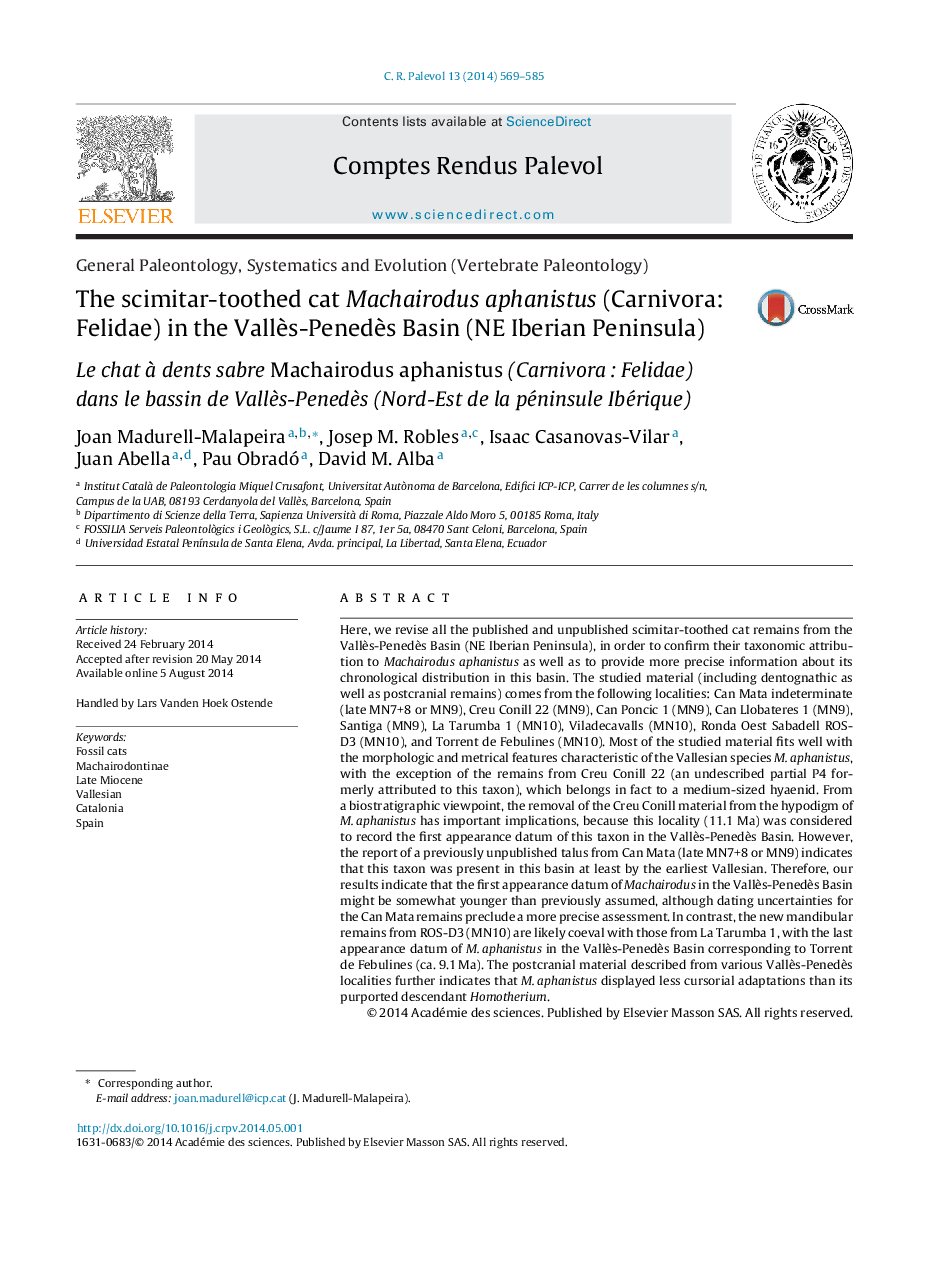| کد مقاله | کد نشریه | سال انتشار | مقاله انگلیسی | نسخه تمام متن |
|---|---|---|---|---|
| 4745723 | 1359777 | 2014 | 17 صفحه PDF | دانلود رایگان |

Here, we revise all the published and unpublished scimitar-toothed cat remains from the Vallès-Penedès Basin (NE Iberian Peninsula), in order to confirm their taxonomic attribution to Machairodus aphanistus as well as to provide more precise information about its chronological distribution in this basin. The studied material (including dentognathic as well as postcranial remains) comes from the following localities: Can Mata indeterminate (late MN7+8 or MN9), Creu Conill 22 (MN9), Can Poncic 1 (MN9), Can Llobateres 1 (MN9), Santiga (MN9), La Tarumba 1 (MN10), Viladecavalls (MN10), Ronda Oest Sabadell ROS-D3 (MN10), and Torrent de Febulines (MN10). Most of the studied material fits well with the morphologic and metrical features characteristic of the Vallesian species M. aphanistus, with the exception of the remains from Creu Conill 22 (an undescribed partial P4 formerly attributed to this taxon), which belongs in fact to a medium-sized hyaenid. From a biostratigraphic viewpoint, the removal of the Creu Conill material from the hypodigm of M. aphanistus has important implications, because this locality (11.1 Ma) was considered to record the first appearance datum of this taxon in the Vallès-Penedès Basin. However, the report of a previously unpublished talus from Can Mata (late MN7+8 or MN9) indicates that this taxon was present in this basin at least by the earliest Vallesian. Therefore, our results indicate that the first appearance datum of Machairodus in the Vallès-Penedès Basin might be somewhat younger than previously assumed, although dating uncertainties for the Can Mata remains preclude a more precise assessment. In contrast, the new mandibular remains from ROS-D3 (MN10) are likely coeval with those from La Tarumba 1, with the last appearance datum of M. aphanistus in the Vallès-Penedès Basin corresponding to Torrent de Febulines (ca. 9.1 Ma). The postcranial material described from various Vallès-Penedès localities further indicates that M. aphanistus displayed less cursorial adaptations than its purported descendant Homotherium.
RésuméLes auteurs présentent la révision de tous les restes (publiés ou non) de chats à dents-sabre du bassin de Vallès-Penedès (Nord-Est de la péninsule Ibérique), afin de confirmer leur attribution taxonomique à Machairodus aphanistus, et aussi de préciser la répartition chronologique de ce Félidé dans ce bassin. Le matériel étudié (qui comprend des restes dentaires et postcrâniens) provient des localités suivantes : Can Mata indéterminé (MN7+8 tardif ou MN9), Creu Conill 22 (MN9), Can Poncic 1 (MN9), Can Llobateres 1 (MN9), Santiga (MN9), La Tarumba 1 (MN10), Viladecavalls (MN10), Ronda Oest Sabadell ROS-D3 (MN10), et Torrent de Febulines (MN10). La plupart du matériel étudié correspond bien aux caractéristiques morphologiques et métriques, typiques de l’espèce vallésienne Machairodus aphanistus, à l’exception des restes de Creu Conill 22 (une P4 partielle, non décrite auparavant, attribuée à ce taxon), qui appartient en fait à un Hyaenidé de taille moyenne. Du point de vue biostratigraphique, l’élimination du matériel de Creu Conill de l’hypodigme de M. aphanistus a d’importantes implications biochronologiques, parce que cette localité (11,1 Ma) a été considérée comme ayant enregistré la première date d’apparition de ce taxon dans le bassin de Vallès-Penedès. Toutefois, un astragale inédit, recueilli à Can Mata (MN7+8 tardif ou MN9) indique que ce taxon était présent dans ce bassin au moins au début du Vallésien. Nos résultats indiquent donc que la première date d’apparition de Machairodus dans le bassin de Vallès-Penedès pourrait être un peu plus précoce qu’on ne l’estimait auparavant, bien que des incertitudes sur la datation des restes de Can Mata empêchent une évaluation plus précise. En revanche, les nouveaux restes mandibulaires de ROS-D3 (MN10) sont à peu près contemporains de ceux de La Tarumba 1, avec la dernière date d’apparition de M. aphanistus dans le bassin de Vallès-Penedès correspondant à Torrent de Febulines (ca. 9,1 Ma). Le matériel postcrânien décrit dans diverses localités du Vallès-Penedès indique, en outre, que M. aphanistus présente moins d’adaptations à la course que son descendant présumé Homotherium.
Journal: Comptes Rendus Palevol - Volume 13, Issue 7, October 2014, Pages 569–585